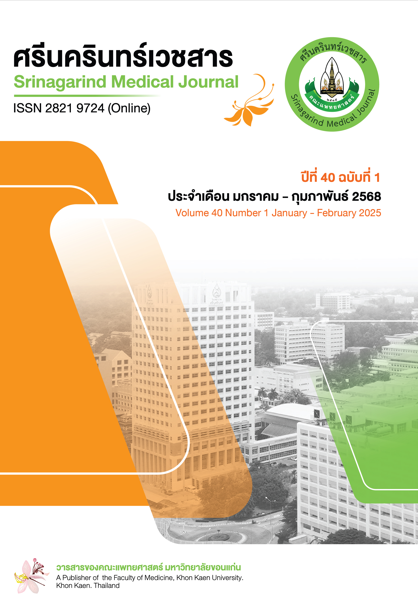Serum Phosphate Levels Following Transition from Continuous Ambulatory Peritoneal Dialysis to Automated Peritoneal Dialysis
Keywords:
serum phosphate, end-stage renal disease, automated peritoneal dialysis, continuous ambulatory peritoneal dialysisAbstract
Background and Objective: With the increasing use of automated peritoneal dialysis (APD) for end-stage renal disease (ESRD) patients in Thailand, comparative data on serum phosphate outcomes between APD and continuous ambulatory peritoneal dialysis (CAPD) remain limited. Phosphate, a large-molecule waste product, may not be adequately cleared through dialysis, and elevated serum phosphate can lead to complications such as renal osteodystrophy and atherosclerosis. This study aims to compare serum phosphate levels in ESRD patients before and after transitioning from CAPD to APD.
Methods: We conducted a retrospective analysis of medical records from ESRD patients who switched from CAPD to APD between July 2019 and June 2024.
Results: Thirty-one ESRD patients transitioned from CAPD to APD, with 48% male, 52% female and a mean age of 59.0 ± 14.4 years. Hypertension and diabetes mellitus were present in 90.3% and 51.6% of patients, respectively. Post-transition serum phosphate levels increased significantly, from 4.3 mg/dL to 6.1 mg/dL (p < 0.001).
Conclusion: Transitioning from CAPD to APD in ESRD patients is associated with a significant increase in serum phosphate levels, highlighting the need for close monitoring in APD patients.
References
Bargman JM, Thorpe KE, Churchill DN. Relative contribution of residual renal function and peritoneal clearance to adequacy of dialysis: a reanalysis of CANUSA study. J Am Soc Nephrol 2001;12(10):2158-62. doi:10.1681/ASN.V12102158.
Heaf JG, Løkkegaard H, Madsen M. Initial survival advantage of peritoneal dialysis relative to haemodialysis. Nephrol Dial Transplant 2002;17(1):112-7. doi:10.1093/ndt/17.1.112.
Schwenger V, Döhler B, Morath C, Zeier M, Opelz G. The role of pretransplant dialysis modality on renal allograft outcome. Nephrol Dial Transplant 2011;26(11):3761-6. doi:10.1093/ndt/gfr132
Shah A, Hashmi MF, Aeddula NR. Chronic kidney disease-mineral bone disorder (CKD-MBD). In: Stat Pearls [Internet]. Treasure Island (FL): StatPearls Publishing; 2024. [cited Oct 10, 2024] Available from: https://pubmed.ncbi.nlm.nih.gov/32809577/
Goodman WG, Goldin J, Kuizon BD, Yoon C, Gales B, Sider D, et al. Coronary-artery calcification in young adults with end-stage renal disease who are undergoing dialysis. N Engl J Med 2000;342(20):1478-83. doi:10.1056/NEJM200005183422003
Rufino M, de Bonis E, Martin M, Rebollo S, Martin B, Miguel R, et al. Is it possible to control hyperphosphataemia with diet, without inducing protein malnutrition? Nephrol Dial Transplant 1998;13(Suppl 3):65–7. doi:10.1093/ndt/13.suppl_3.65.
Sperschneider H, Gunther K, Marzoll I, Kirchner E, Stein G. Calcium carbonate (CaCO3): an efficient and safe phosphate binder in haemodialysis patients? A 3-year study. Nephrol Dial Transplant 1993;8(6):530–4. doi:10.1093/ndt/8.6.530.
Wang AY, Woo J, Sea MM, Law MC, Lui SF, Li PK. Hyperphosphatemia in Chinese peritoneal dialysis patients with and without residual kidney function: What are the implications? Am J Kidney Dis 2004;43(4):712–20. doi:10.1053/j.ajkd.2003.12.032
Debowska M, Gomez R, Pinto J, Waniewski J, Lindholm B. Phosphate clearance in peritoneal dialysis. Sci Rep 2020;10(1):17504. doi:10.1038/s41598-020-74412-2.
Ansell D. Serum phosphate and outcomes in PD patients. Nephrol Dial Transplant 2007;22(2):667–8. doi:10.1093/ndt/gfl593.
Noordzij M, Korevaar JC, Bos WJ, Boeschoten EW, Dekker FW, Bossuyt PM, et al. Mineral metabolism and cardiovascular morbidity and mortality risk: peritoneal dialysis patients compared with haemodialysis patients. Nephrol Dial Transplant 2006;21(9):2513–20. doi: 10.1093/ndt/gfl257.
Downloads
Published
How to Cite
Issue
Section
License
Copyright (c) 2025 Srinagarind Medical Journal

This work is licensed under a Creative Commons Attribution-NonCommercial-NoDerivatives 4.0 International License.



